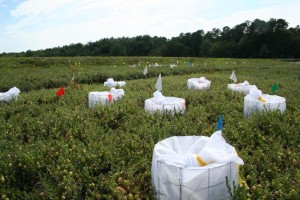Sparganothis fruitworm and spotted fireworm are important pests of cranberries; therefore, plant resistance against these insects is a major topic of study.
Both insects feed on cranberry uprights and developing fruit during the summer. Dr. Elvira de Lange, a postdoc at the Blueberry and Cranberry Research Center, is especially interested in the resistance factors against these insects that are naturally present in cranberry fruits.
Last week, she harvested developing fruits from 10 cranberry varieties that are grown in an experimental bog to analyze them for concentrations of defensive compounds. Cranberry fruits contain various compounds that can be toxic to insects, like certain flavonols. Interestingly, flavonols may be the compounds responsible for the health benefits of cranberry products for humans.
To evaluate which cranberry varieties are more susceptible or more resistant to Sparganothis fruitworm and spotted fireworm, Elvira has put a large number of cages out in the experimental bog. She introduced Sparganothis fruitworm in half the cages, and spotted fireworm in the other half. A week later, she retrieved the larvae from the cages and weighted them, to know on which varieties they grew best (relatively susceptible varieties) and on which varieties they grew less (relatively resistant varieties).
Elvira will try to correlate resistance or susceptibility of cranberry varieties to the presence of flavonols in the fruits, in order to elucidate what makes resistant cranberry plants resistant. This may help to target breeding for more resistant varieties.


